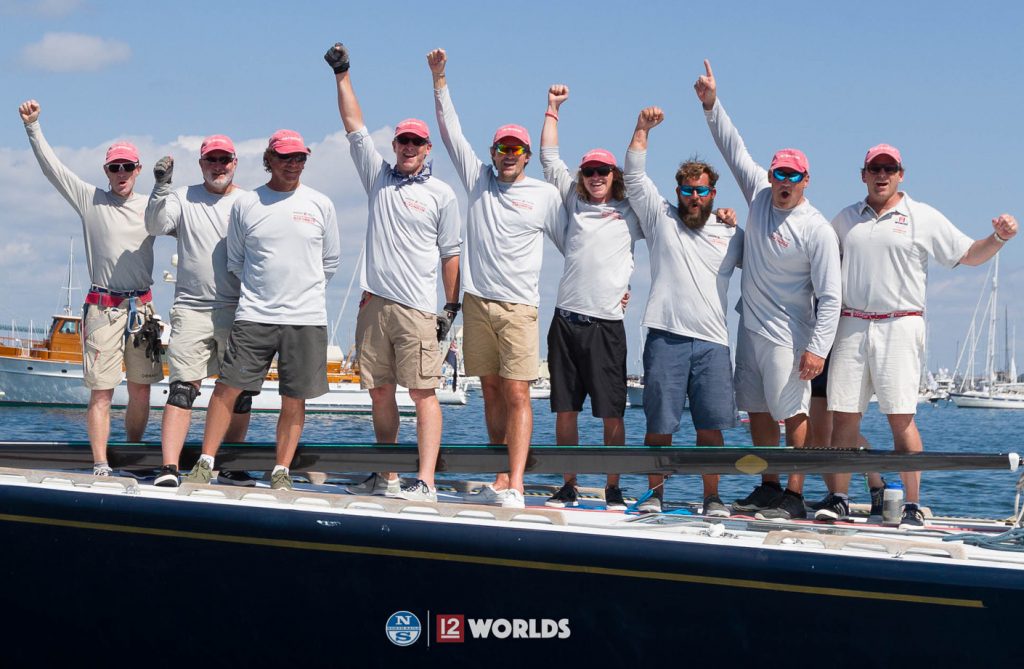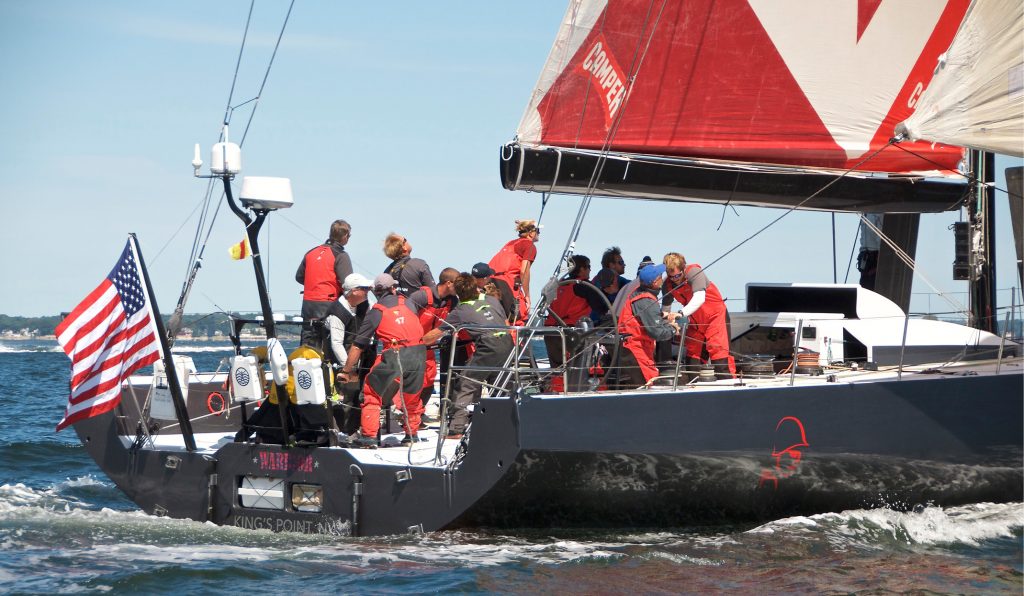By Joe Cooper
Of all the aspects of sailing that are constant across every discipline of the sport, it is the community we find ourselves in that most often becomes the standout component. The mates, the stories, the highs and the lows, the fear and the high fives, the shared experiences are the fundamental glue we all have in common in the sailing milieu. Think for a moment on what other aspects of our lives offer the same breadth and depth of experiences that those who do not sail miss out on? I can think of only one other field of endeavor that offers that same experience: The military.

Warrior Sailor Anthony Villalobos (third from right) was a grinder on Defender for this year’s 12 Metre World Championship in Newport. © Ian Roman
It is no surprise then that introduction to the world of sailing is very powerful medicine to those military personnel who fall under the umbrella of a medical discharge. These parallels between the military and sailing are nurtured and developed by a non-profit based out of the United States Merchant Marine Academy Foundation at Kings Point, NY.
Warrior Sailing is the outgrowth of a program offered by US Sailing a few years ago to introduce medically discharged military personnel to the sailing world. Two of the coaches at one of those basic training days were Ben Poucher and Ralf Steitz. Ben and Ralfie are two of the sailing community’s most experienced sailors. Ralfie is the Executive Director of the USMMA Foundation and Ben is the Program Coordinator of Warrior Sailing. The US Sailing program was a great opportunity, but Ben and Ralfie wanted to expand the idea beyond what was at the time a “come for a sail” program with no “next step.”

Several Warrior Sailors sailed on Stephen Murray’s Volvo 70 Warrior in the 2017 Vineyard Race. © Rick Bannerot/OntheFlyPhoto.net
We often hear of the difficulties discharged personnel have in returning to civilian life and I see reports of upwards of 22 former U.S. servicemen and women taking their own lives on a daily basis. Ben and Ralfie wanted to take the idea beyond a one- or two-day sailing experience and leverage the vast universe of sailing to give former military another community that they recognize.
Warrior Sailing has expanded over the past half a dozen years to the point where they now have Basic Training Camps at thirteen partner venues around the country. To date, Basic Training Camps have been held at Sail Newport, San Diego Yacht Club, Fort Worth Boat Club, Annapolis, and venues in the Midwest.
The Basic Training Camp schedule is similar to “regular” Learn to Sail programs in the content and format. It is almost all sailing. After a couple of hours coming to grips with some basic principles and language, participants go straight into the sailing portion of the program. Warrior Sailing covers all the costs, and Warrior Sailors who live outside the area of the Training Camp have their transportation expenses reimbursed on arrival.
One of the fundamentals Ben and Ralfie wanted from the beginning is a “pathway” for graduates of the Basic Training Camps to continue sailing. For this, they offer the American Sailing Association’s Basic Keelboat Sailing program. Warrior Sailors who wish to may become certified in Basic Keelboat Sailing, but such certification is based on each sailor’s interest. And then?
For those Warrior Sailors who really get a serious dose of the “Sailing Bug,” Warrior Sailing offers the opportunity to do deliveries aboard the USMMA Foundation’s boats. These are often multi-day offshore passages where, as we are all well aware, the onus is on the skipper and crew to work together as a team – a unit – to ensure a safe passage and successful delivery. And as with all deliveries, there are plenty of opportunities for the crew to exercise the skills of seamanship and so for many of the Warrior Sailors to use some of the practical skills they were trained for in the Military. There is a mechanism for Warrior Sailors to log hours towards certifications and licenses, too.
In the recently completed Chicago to Mac Race, the Warrior Sailing program finished sixth of fifteen in their division. In advance of the subsequent Port Huron to Mac Race, The Detroit News ran a piece on the Farr 53 Warrior and the comments from the crew interviewed are perfectly in line with other comments I have heard from Warrior Sailors. “Bad food, bad conditions, cramped conditions,” remarked retired Air Force Master Sergeant Dan DeWent, “but we’re not being shot at and not getting blown up so it is pretty easy.” DeWent credits sailing with “haven given me a purpose to live again.”
At the 12 Metre World Championship in July, Defender (12 US 33) had two touch points with Warrior Sailing. The boat’s program for the Worlds used the event as a fundraiser and PR exposure vehicle for Warrior Sailing. Every other boat had a battle flag with that boat’s name in it, but Defender’s flag read “Warrior Sailing.” A second, much more literally flesh and blood touch point, was a graduate of the Warrior Sailing Program sailing as a grinder.
Anthony Villalobos joined the U.S Army at 17. He is second generation military, as are his siblings. Hailing from Winston-Salem, NC, Anthony had never sailed in his life and his first exposure to the beach was senior week of his senior year in high school, just before being deployed to Iraq. When I talked with him in August, Anthony’s trajectory sounded very much like that of many young men and women in the days and years after 9/11. He served two tours in Iraq and one in Afghanistan. He was first wounded at 18, taking shrapnel in his right arm. He returned to Iraq two more times because, as he chuckles, “I had not learned my lesson.” “A prime candidate for a sailor,” I joked, and he nodded and laughed louder.
Anthony’s specialty was explosives, but after driving over improvised explosive devices (six times in ten months!) which resulted in a long list of physical injuries, he was medically discharged. “How did you get to Warrior Sailing?” I asked. A mate of Anthony’s asked him if he wanted to go to Galveston,a TX and learn to sail. The idea intrigued him, and a week later he found himself aboard a Sonar under the watchful eye of Ralfie Steitz. After the second day, the beginning of racing, he had fallen in love with sailing. At the conclusion of that Basic Training Camp, he expressed interest in doing more sailing and shortly afterwards found himself (one of five Warrior Sailors in the crew) as the mainsheet trimmer on an 84-foot boat at Sperry Charleston Race Week in 2018. Following the regatta, he was part of the delivery crew bringing her to Baltimore on his first offshore delivery. The rest, as they say, is history.
Anthony moved to the Northeast, and as well as doing deliveries, he is now part of the permanent crew on Pterodactyl, an R/P 45, and sailed with us on Defender for the 12 Metre Worlds, where I first met him.
Anthony is one of the 75% of Warrior Sailors who show no outward physical signs of being wounded in some way, and I was flabbergasted to hear about his short military career ending in a medical discharge. Between a week of 12 Metre sailing with him as “my grinder,” and a long yarn with him after the Ida Lewis Distance Race (he sailed on Pterodactyl), I heard more about his view on the similarities between the military and sailing communities.
The common thread is community and shared experiences as a team. Both enterprises only work at their best when every part of the machine is working in harmony with the rest. Anthony remarked on the great sense of being when he is part of a team, with a common goal. That certainly describes the military and sailing to a T.
I asked Anthony, “What was it about the question his mate put to him that excited you?” His reply was pretty close to, “It seemed like a good idea at the time.” Anthony had no experience with the sea, sailing, or boats, yet jumping into a Sonar for three days of basic sailing instruction changed his life.
The idea that there is always something more to be done, that you can learn something new every day, be a bit better, do a better job, is something Anthony spoke of about his time so far in the sailing world. I commented that such a sentence could have easily come from a military training manual, a proposition to which he readily agreed and cited as one of the reasons he loves sailing so much. Another common thread in his tale was the responsibility you either are given or take up in the military and sailing. He was a Staff Sergeant at 21, and when I asked if that was unusual, he nodded a very positive, “Oh, yeah!”
Anthony has been logging his miles towards sitting for his (ship) Captain license exam, and has a few things on his To DO list: Running his own boat, the Newport Bermuda Race 2020, and the Transatlantic Race. From my own pretty short time sailing with him, I reckon that the sailing world has won a great new participant and for anyone in need of a very solid hand aboard, Anthony should be on the shortlist. To learn more about Warrior Sailing, log onto
warriorsailing.org. ■




